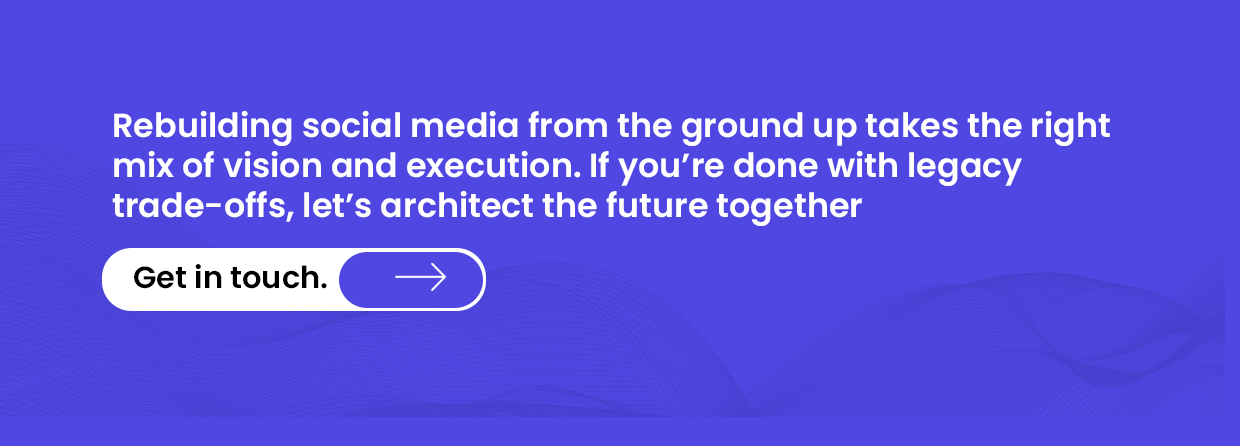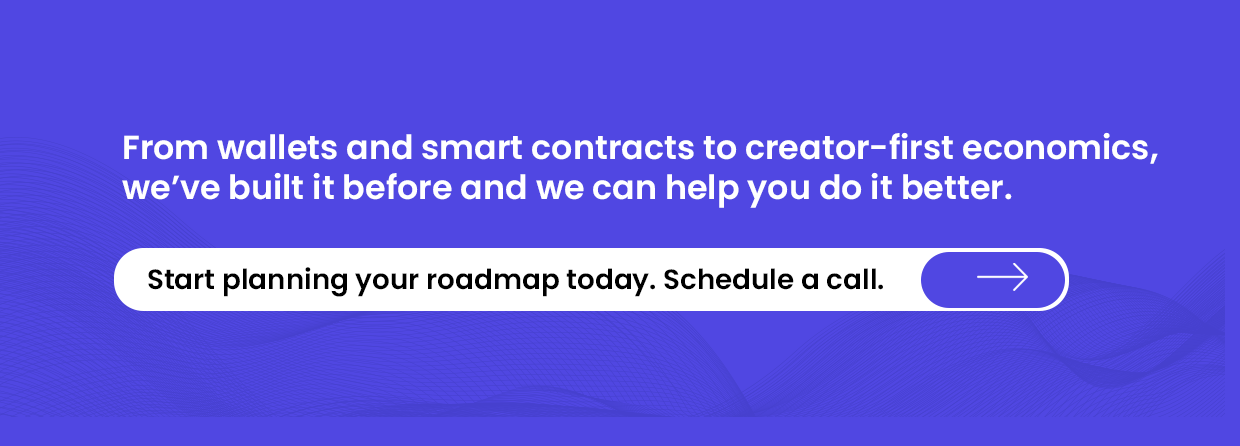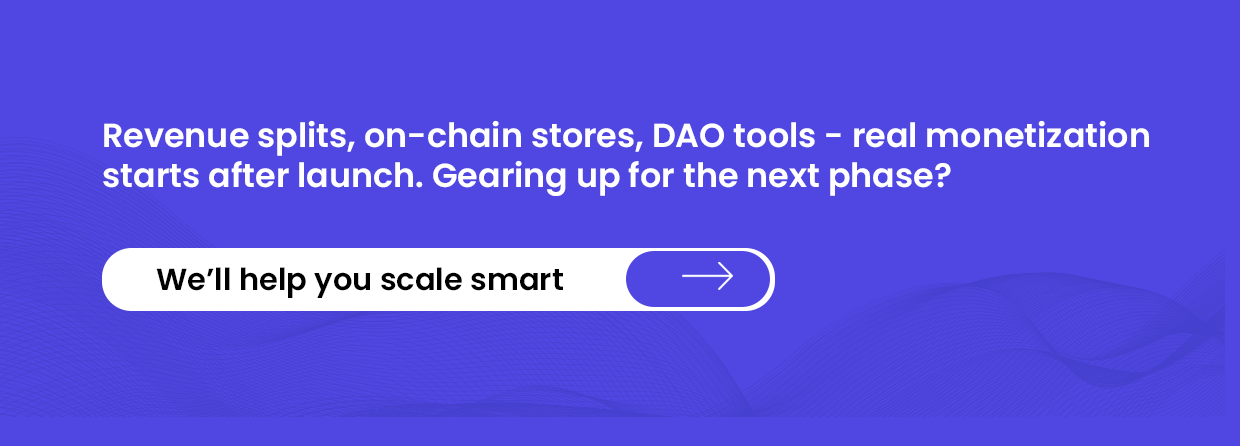
Imagine a social platform where creators don’t have to beg algorithms for reach, fight for fair payouts, or worry that their audience could disappear the next time a platform changes its policy. That’s not a fantasy anymore – it’s Own. And it’s showing the world what happens when you mix creator-first thinking with blockchain-backed ownership.
With a swipeable feed like TikTok and crypto-powered monetization under the hood, Own is quietly redefining what it means to build social apps in 2025. It’s fast, it’s slick, and it’s rooted in one fundamental shift: putting creators in control of their content, their earnings, and their communities.
So, what does it take to build something like Own?
Spoiler: it’s more than just slapping tokens onto a feed. You’re building a new kind of digital economy – one where content has traceable value, engagement is incentivized, and the platform grows with its users, not at their expense.
In this guide, we’ll unpack everything you need to know to architect your own creator-first, decentralized social media experience – from picking the right tech stack and blockchain layer to solving real-world UX challenges and designing tokenomics that actually work.
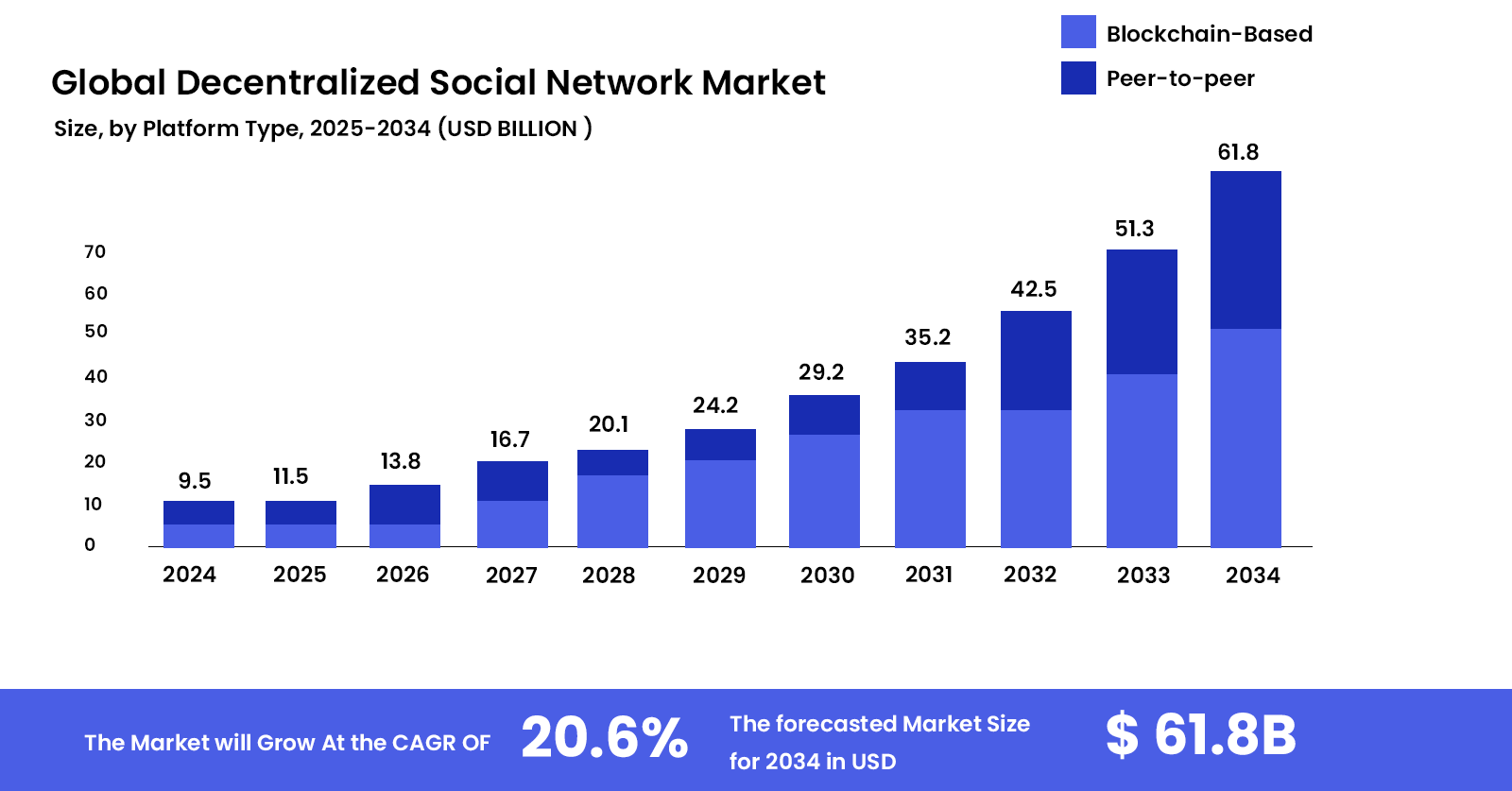
Why the World Needs Decentralized Social Media Now
Social media as we know it is broken – and creators are the ones paying the price. On traditional platforms, you don’t own your content, your audience, or even your reach. The algorithm decides what gets seen. The platform decides who gets paid. And if they flip a switch tomorrow, your years of work can vanish overnight.
That’s why decentralized platforms like Own are striking a nerve.
They offer a fundamentally different social contract – one where creators have ownership, transparency is built-in, and monetization isn’t filtered through layers of middlemen.
Here’s why this shift matters more now than ever:
Creators Are Building the Value, But Earning Pennies
Today’s creators drive billions in revenue for platforms – but get a fraction in return. TikTok takes up to 50% of creator tips. Instagram doesn’t even offer native tipping. In contrast, Own gives creators 80–95% of the earnings. That’s the power of decentralized revenue models.
Web2 Platforms Are Walled Gardens
You build an audience on Instagram or YouTube, but you can’t take them with you. If you leave, you leave with nothing. Decentralized identity systems (like wallet-based logins or NFT profiles) give creators portable audiences and true content ownership – an idea whose time has come.
Algorithms Are Black Boxes
Why does one post go viral while another tanks? Why are creators shadowbanned without explanation? Centralized algorithms thrive on opacity. Decentralized platforms are experimenting with transparent, open-sourced curation models – where feed logic can be understood, audited, and even forked.
Moderation and Platform Policy Are Top-Down
The way content is policed, monetized, or promoted is often decided by opaque teams behind closed doors. Decentralized platforms offer a chance to put governance in the hands of the community – with on-chain voting, creator councils, or tiered permissions.
Global Access, Uncensored Opportunity
In many countries, creators are censored or deplatformed for political or cultural reasons. With Web3 social, content can live on decentralized storage, and monetization can happen peer-to-peer – opening up access where traditional platforms impose limits.
In short, decentralized social media isn’t just about buzzwords like Web3 or blockchain. It’s about building platforms that are fairer, freer, and creator-aligned by design. Platforms like Own aren’t just fixing social media – they’re rebuilding it from the ground up.
Core Features to Include in a Decentralized Social Media Platform Like Own
To compete in the next generation of social media, your platform needs more than a Web3 label. It needs to deliver a creator-first experience that’s technically robust, economically fair, and just as seamless as its Web2 counterparts. Below are the core features you’ll need to prioritize from day one.
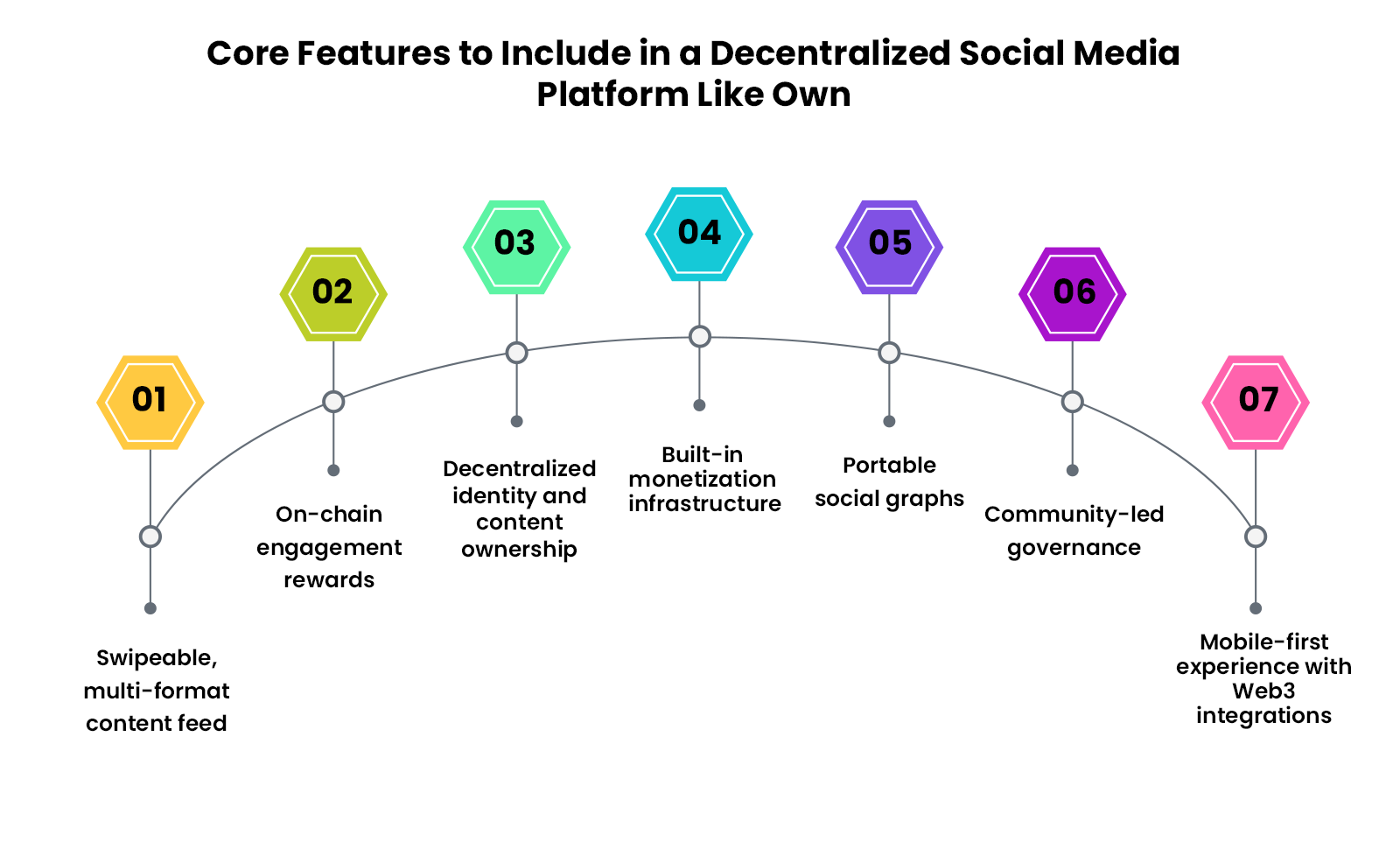
Swipeable, multi-format content feed
A smooth, vertically scrollable feed is table stakes. Your platform must support video, image, carousel, and text formats in a way that feels as familiar and fluid as TikTok or Instagram Reels. The key difference lies in the feed algorithm – it should prioritize transparency and engagement-based logic, not opaque ranking formulas.
On-chain engagement rewards
Own introduced a powerful concept: token-based compensation for every meaningful engagement. Your platform should implement a native utility token or integrate an existing one that tracks likes, shares, and time spent. Smart contracts must handle reward distribution automatically, without centralized gatekeeping.
Decentralized identity and content ownership
Traditional login credentials give way to wallet-based authentication. This enables users to own not only their account but also their content and audience. Content should be stored on-chain or via decentralized file systems like IPFS, with clear attribution and transferability.
Built-in monetization infrastructure
Creators should be able to earn from multiple streams: tipping, branded partnerships, paid unlocks, affiliate links, and direct-to-fan commerce. Your app should offer transparent revenue splits, with smart contracts enforcing payouts automatically. Key advantage: no minimum follower thresholds or platform-side delays.
Portable social graphs
One of the biggest Web2 constraints is the platform lock-in of followers. Consider building on or integrating with decentralized social graphs (such as Lens Protocol or Farcaster) that allow users to carry their audience across apps without loss of reach or engagement.
Community-led governance
Moderation, feature development, and policy updates shouldn’t be dictated top-down. A decentralized platform should offer mechanisms for token-holder voting, creator councils, or open-source governance participation – ensuring users shape the product roadmap.
Mobile-first experience with Web3 integrations
Regardless of decentralization, poor UX is a deal-breaker. Your app needs to match mainstream performance benchmarks while integrating wallet connections, token transactions, and secure session handling behind the scenes. Every layer of Web3 must be invisible unless it needs to be surfaced.
Designing for Trust, Speed, and Stickiness
If your decentralized platform doesn’t feel instantly usable, it won’t matter how fair your tokenomics are. Users – especially creators – aren’t joining for ideology. They’re joining for reach, monetization, and frictionless creation. That means your app needs to look and behave like a product they already trust… just better.
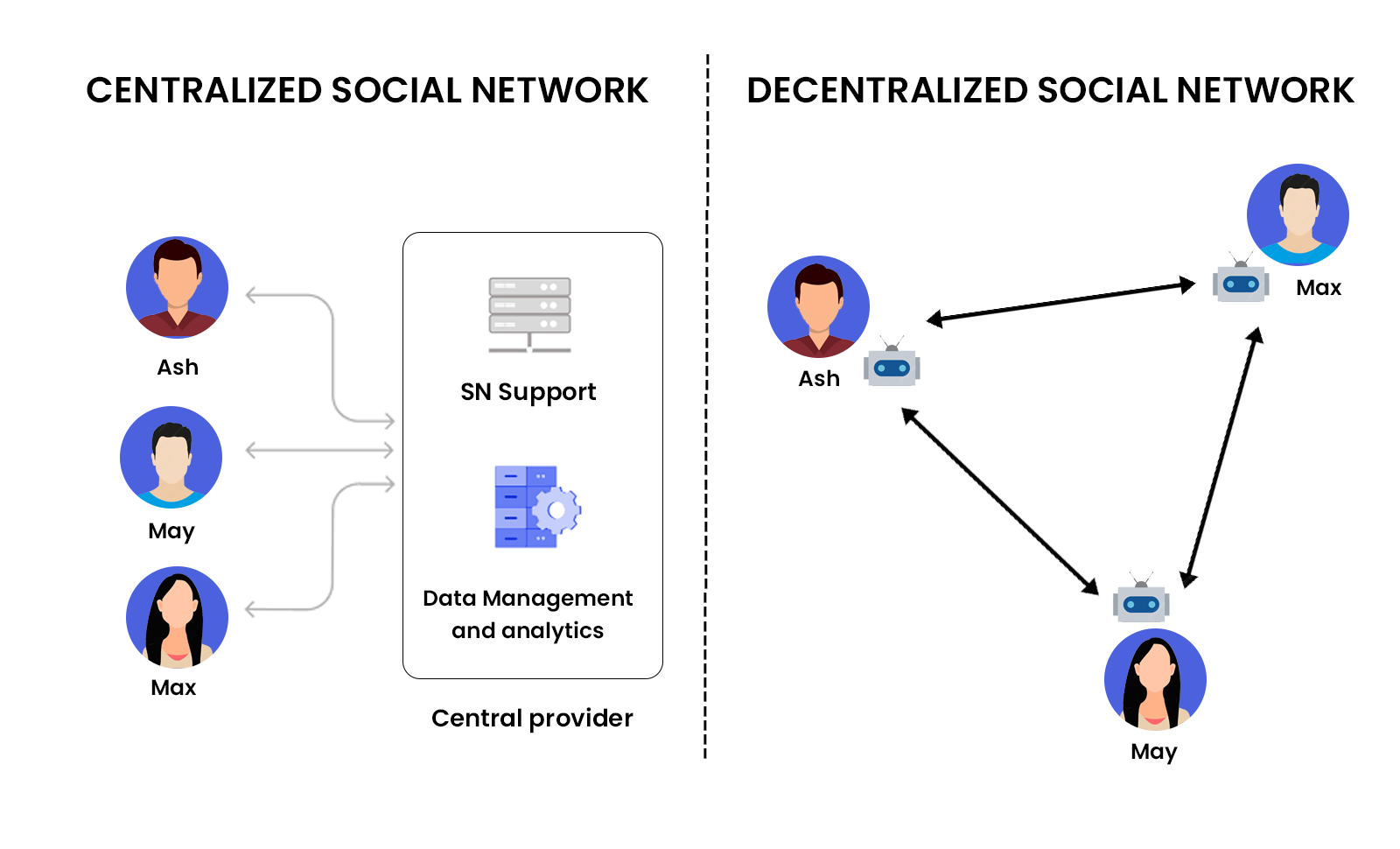
Here’s what to prioritize when designing the UX and UI for a Web3-native social media experience:
Start with Web2 familiarity, then introduce Web3 gradually
Most users aren’t crypto-native. Your interface should feel like something they already know – TikTok, Threads, Instagram. Logins, posting, following, and commenting must all feel intuitive. Introduce wallet connections, token rewards, and NFT-based identity only when the user has enough context to care.
Prioritize speed over polish in v1
Early adopters won’t tolerate lag. If videos buffer, wallets timeout, or feeds stutter, they’ll churn. Decentralized doesn’t mean slow. Use edge caching, progressive loading, and mobile-native animations to make the app feel as snappy as any centralized competitor.
Design for mobile-first, touch-native behaviors
Most content consumption happens on mobile. Your UI should be optimized for swipes, taps, and full-screen storytelling. Buttons need to be thumb-friendly, transitions need to feel native, and modal flows (like tipping or minting) should never interrupt core usage.
Make wallet login feel invisible
A first-time user shouldn’t feel like they need to understand Ethereum or Base to sign up. Use social login bridges (via tools like Web3Auth or Privy), pre-fill wallets where possible, and explain what’s happening in plain language. A good rule: if they have to Google it, you’re doing too much too soon.
Visualize ownership, not just activity
One key opportunity in decentralized apps is to show creators what they own – not just what they’ve posted. Profiles should include tokens earned, content licenses held, and even follower NFTs or supporter badges. Give creators a dashboard they can flex.
Don’t bury monetization behind complexity
Whether it’s tipping, unlocking content, or earning from post engagement, monetization flows should feel effortless. Guide users with inline tooltips, micro-tutorials, and real-time earnings indicators. If creators don’t see the value quickly, they won’t stay long enough to learn it.
Design is your conversion funnel. It’s what earns user trust in a space that’s still new, unfamiliar, and often intimidating. Get the UX right, and your users won’t care that it’s decentralized – they’ll just care that it works.
Tech Stack for Building a Decentralized Social Media Platform Like Own
Decentralization doesn’t mean reinventing everything from scratch – but it does mean making thoughtful choices about where control lives, how data flows, and how value is exchanged. Building something like Own requires blending familiar Web2 app components with robust Web3 infrastructure.
Below is a breakdown of what your stack might look like across layers:
Frontend (Mobile/Web Interface)
- React Native or Flutter – For cross-platform mobile development
- Next.js or React – For any web-based portals or dashboards
- Framer Motion, Lottie, Reanimated – To add scroll-smooth microinteractions
- Wallet integrations – MetaMask, WalletConnect, Coinbase Wallet, Web3Modal
Backend / APIs / Microservices
- Node.js, Go, or Rust – Lightweight, high-performance service logic
- GraphQL or REST – For querying user data, content feeds, etc.
- Firebase / Supabase / AWS Amplify – For push notifications, real-time sync
- IPFS / Arweave – For decentralized media storage
- Livepeer – For decentralized video streaming, if you’re avoiding Web2 CDNs
Blockchain Layer
- Base or Polygon – Fast, low-cost Ethereum-compatible L2s
- Ethereum Mainnet – For high-value NFT minting or DAOs
- Solana – If speed and low fees are top priority
- Smart contracts – Use Solidity (EVM chains) or Rust (Solana) to power tipping, content licenses, post boosting, staking, etc.
Tokenomics & Smart Contracts
- Creator reward calculation and payouts
- Tipping and microtransactions
- NFT minting (for identity, content ownership, or membership)
- Voting and governance (DAO frameworks like Tally or Snapshot)
Tools like OpenZeppelin, Thirdweb, or Mirror can help accelerate deployment with audited contract templates.
Decentralized Identity & Social Graph
- Lens Protocol – Modular identity + social graph system
- Farcaster Protocol – Decentralized, portable social identities
- ENS or Unstoppable Domains – For human-readable wallet usernames
Analytics & Monitoring
- Plausible Analytics or PostHog – For privacy-first product analytics
- The Graph – To index and query on-chain data efficiently
- Tenderly – For monitoring smart contract execution
The best decentralized apps don’t overdo it with on-chain logic. They find the right balance – pushing value, transparency, and ownership to the blockchain, while keeping UX-driven interactions fast and responsive off-chain.
What Does it Cost to Build a Decentralized Social Media Platform Like Own?
Building a decentralized social media app isn’t a weekend project – it’s a multi-layered platform with blockchain infrastructure, token economics, and high user expectations for design and performance. Your cost will largely depend on how ambitious your first version is – and how much of it you aim to build in-house vs. outsource.
Here’s a rough estimate based on project complexity:
1. MVP (Lean Validation-Ready Version)
- Includes wallet login, basic feed, tipping via tokens, and minimal content types.
- Core Features: Wallet-based signup, post creation, feed scroll, engagement tracking, basic token reward logic, mobile-first UI
- Blockchain Layer: Integration with an existing chain (e.g., Base or Polygon), using third-party contracts (Thirdweb, OpenZeppelin)
- Estimated Cost: $60,000 – $120,000
- Timeline: 3–5 months
Best for: Founders testing token utility and early creator adoption before scaling features.
2. Mid-Tier Build (Scalable Beta with Monetization)
Adds tipping, creator dashboards, advanced analytics, NFT-based content ownership, branded partnerships.
- Core Features: Creator analytics, tokenized earnings breakdown, decentralized content storage (e.g., IPFS), governance voting modules, profile NFTs
- Smart Contracts: Custom token contracts, licensing logic, creator earnings engine
- Estimated Cost: $150,000 – $300,000
- Timeline: 5–8 months
Best for: Startups looking to raise funding or launch in controlled public beta with revenue-ready tools.
3. Full-Scale Platform (Own-Level Ambition)
Full monetization suite, transparent curation algorithm, multi-chain support, DAO governance, branded partnerships, and a real-time reward engine.
- Core Features: Creator shops, sponsored content flows, AI-driven moderation, cross-chain wallet support, token buyback mechanics, DAO management interface
- Smart Contracts: Advanced custom contracts for royalties, licensing, staking, and treasury management
- Estimated Cost: $400,000 – $750,000+
- Timeline: 9–14 months
Best for: Venture-backed projects aiming to scale globally with tokenomics, regulatory review, and creator marketplace integrations.
Keep in mind – those figures are just the starting point. The real budget can shift based on decisions around:
- Design quality and animation detail
- Token compliance and legal consultation
- Ongoing infrastructure and gas cost management
- Post-launch support, iteration, and governance setup
If you’re aiming for something fast, lean, and impactful, start with an MVP focused on creator value and on-chain transparency. You can always evolve toward Own’s scale once you’ve validated the model.
Monetization Models and Token Design Strategy
In a decentralized social app, your monetization strategy isn’t just about ad revenue or subscriptions – it’s about creating a token-powered economy that benefits both the platform and the people who create for it. Own’s use of the $OWN token is a strong example: users engage, creators earn, and the token gains value as adoption scales.
But launching your own token without a clear strategy? That’s a fast track to user distrust or regulatory headaches.
Here’s how to approach token design and monetization that works in real-world conditions:
- Engagement-Based Earning
Reward creators for what drives value – likes, shares, time watched, follower growth. Set smart contract logic to distribute your native token accordingly. You can create reward tiers (e.g., viral bonuses) or rate adjustments based on platform revenue or token stability. - Tipping and Microtransactions
Let fans tip their favorite creators directly with your token – or with stablecoins that convert to your token in-app. Make the flow seamless and mobile-friendly. Display real-time earnings in dashboards to reinforce trust and momentum. - Branded Content and Sponsorships
Offer a framework where brands can pay creators using the token, with smart contracts that enforce terms. You might take a platform cut (like Own’s 10%) while letting creators keep 90% – a massive improvement over traditional platforms. - Creator Stores and Exclusive Drops
Enable token-gated content, NFTs, downloadable assets, or merch stores – all powered by the same identity layer. Make it easy for creators to monetize beyond just posts, with automatic royalty splits if needed. - Token Buybacks and Treasury Mechanics
To support token demand and reduce inflation, allocate a portion of platform revenue to buy back tokens periodically from the open market – like Own plans to do. This also increases scarcity and shows commitment to long-term token value. - On-Chain Governance (Optional in Phase 2)
Once your user base grows, invite the community to propose or vote on key decisions using your token. Governance can impact feature releases, fee structures, or content policy. Use Snapshot, Tally, or custom DAO tooling.
When done right, tokenomics should drive real user behavior – not speculation. Your token isn’t just currency. It’s the core incentive engine of your ecosystem. It should reward early adopters, reinforce positive participation, and help creators feel they truly own their platform equity.
Challenges in Building a Decentralized Social Platform and How to Solve Them
Building a decentralized social platform like Own isn’t just about technical architecture – it’s about navigating a new set of trade-offs that don’t exist in traditional app development. You’re no longer just building a product. You’re building trust, community, and an economy from day one.
Here are the most common challenges – and how smart teams are addressing them.
- User Onboarding in a Web3 World
The problem: Wallets, gas fees, and token concepts overwhelm new users.
The solution: Use social login bridges (Web3Auth, Privy), pre-created wallets, or in-app custodial wallets that feel like standard signups. Educate contextually – don’t dump crypto jargon on the home screen. - Balancing Decentralization with UX
The problem: Full decentralization can lead to slow load times, clunky interfaces, and poor moderation.
The solution: Take a hybrid approach. Keep ownership and monetization on-chain, but run performance-critical components (feeds, profiles, search) on centralized infra or edge networks. Use IPFS selectively. - Tokenomics That Don’t Break Under Pressure
The problem: Without strong demand mechanisms, your token may lose value, or worse – get exploited.
The solution: Bake in utility. Use token staking, platform fee payments, and exclusive creator unlocks to keep demand high. Automate buybacks from platform revenue to stabilize price. - Content Moderation at Scale
The problem: On-chain data is immutable – and decentralization often lacks content oversight.
The solution: Implement client-side moderation filters, community flagging systems, and optional verified creator tiers. Some moderation logic can be managed via DAO votes or third-party trust layers. - Regulatory Grey Zones
The problem: Token-based monetization + creator payouts = possible securities concerns.
The solution: Work with legal advisors to issue tokens with utility (not investment) framing. Consider a two-token model: one for rewards, one for governance. Avoid promising financial returns. - Building a Community Without a Platform Yet
The problem: You need users to build value – but the app needs value to attract users.
The solution: Start building community before launch. Launch on Discord, build in public on X (Twitter), create waitlists, give early access to creators, and airdrop tokens to high-engagement users.
Decentralized platforms are harder to build than their Web2 counterparts – but they’re also stickier when done right. If your creators feel ownership from day one, they won’t just use the platform – they’ll defend it, shape it, and grow it alongside you.
Why CodingWorkX Is the Right Tech Partner for This Build
You’re not building just another app – you’re architecting a new kind of economy. That takes more than just blockchain developers. It takes a team that understands what it means to go to market fast, validate real-world behavior, and build a product that feels like magic… even when it’s powered by smart contracts under the hood.
At CodingWorkX, we bring a lean, product-first approach to Web3. We’ve helped startups across fintech, creator tech, and consumer apps launch MVPs that scale. With every decentralized product, we obsess over one thing: what real users will actually use.
Whether you’re exploring a token-based tipping model, building a portable creator identity layer, or rolling out smart contract logic for engagement rewards – we know how to move fast without breaking your architecture or your community’s trust. We don’t just write code. We design systems that scale, earn, and evolve. If you’re serious about building the next Own, let’s make it happen – together.
FAQs.
Q. What is a decentralized social media platform?
Ans. A decentralized social media platform removes central ownership and control from a single entity. Instead of relying on a company to store, moderate, and monetize content, it uses blockchain or peer-to-peer networks to give users direct control over their data, identity, and earnings. Features like wallet-based login, on-chain content storage, and tokenized rewards allow users and creators to truly “own” their profiles, audiences, and content. If you’re planning to build in this space, CodingWorkX can help you turn this vision into a working, scalable platform.
Q. How is Web3 changing social media?
Ans. Web3 is reshaping social media by introducing decentralization, token-based economies, and user ownership. Creators no longer rely on platforms to earn revenue—smart contracts allow peer-to-peer tipping, branded partnerships, and automated royalty payouts. Users gain control over their data and identity via wallets and decentralized profiles. Algorithms and governance are increasingly transparent, driven by communities, not corporations. With the right tech and UX, Web3 social platforms can feel just as smooth as Web2—only fairer. CodingWorkX specializes in making that happen.
Q. What tech stack do I need for a blockchain social app?
Ans. A typical decentralized social app uses a mix of traditional and Web3 tools:
- Frontend: React Native, Next.js, or Flutter
- Backend: Node.js, GraphQL, or Go
- Blockchain: Ethereum, Polygon, or Base with smart contracts using Solidity
- Storage: IPFS, Arweave, or Filecoin for decentralized media
- Identity: WalletConnect, Lens Protocol, or ENS
- Extras: The Graph (indexing), Thirdweb, or OpenZeppelin for smart contract libraries
Choosing the right stack depends on your audience, features, and scalability goals. CodingWorkX helps tailor this stack to your product vision.
Q. What are the security benefits of decentralized platforms?
Ans. Decentralized platforms offer several built-in security advantages:
- No central point of failure: Data is distributed, reducing risks of large-scale breaches.
- Ownership & privacy: Users control their keys, content, and identity.
- Tamper-resistance: Blockchain records are immutable, meaning interactions can’t be secretly edited or deleted.
- Smart contract automation: Payouts and governance happen via code, not admin panels.
However, security still depends on strong smart contract audits and privacy-preserving design. CodingWorkX ensures your platform architecture is secure from both Web2 and Web3 attack vectors.
Q. How much does it cost to build a decentralized social media app?
Ans. Costs vary widely depending on the feature set and scale.
- Lean MVPs (with basic wallet login, token rewards, and content feed): $60K–$120K
- Mid-tier platforms (with creator monetization, NFTs, dashboards): $150K–$300K
- Full-scale apps (multi-chain, DAO, real-time moderation): $400K+
These estimates exclude ongoing infrastructure, legal consulting, or scaling support. At CodingWorkX, we help you plan smartly—starting lean where it makes sense, and scaling once traction is proven.
Q. Can decentralized social apps scale like mainstream platforms?
Ans. Yes—if built right. Web3 infrastructure has matured significantly, with layer-2 chains (like Base or Arbitrum), scalable smart contract platforms, and decentralized storage that can handle millions of users. The key to scaling is smart architecture: combining blockchain for value transfer with traditional systems for speed and UI. Social graphs, media rendering, and governance can all be optimized over time. CodingWorkX builds with scalability in mind, so you don’t hit blockers as you grow.
Q. Why choose CodingWorkX to build Web3 social media apps?
Ans. We don’t just build blockchain features—we build usable, scalable Web3 products. At CodingWorkX, we combine deep expertise in smart contracts, token economies, and wallet integrations with real-world UX and mobile-first thinking. We’ve helped startups go from whiteboard to working dApp—balancing decentralization with performance, and transparency with monetization. Whether you’re validating an MVP or scaling a tokenized creator platform, we’re the team that knows what it takes to make it work for both users and investors.

